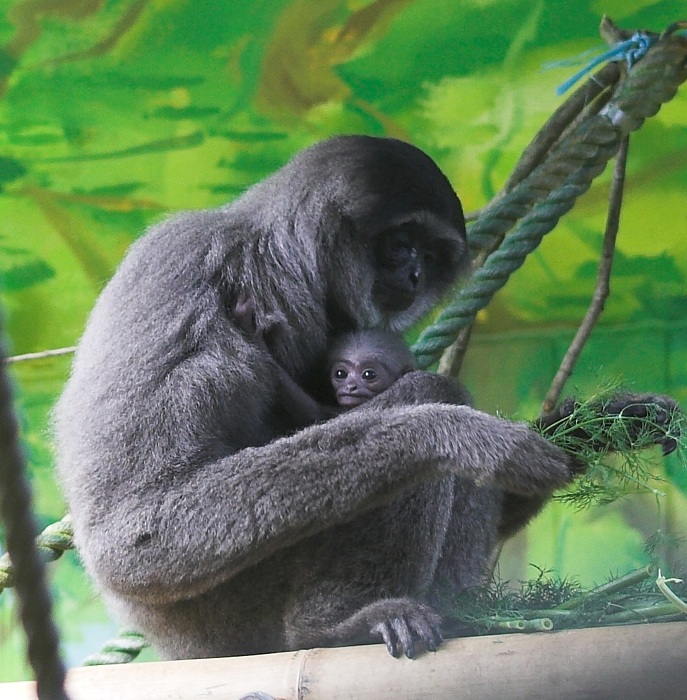- Silvery Gibbon
Taxobox
name = Silvery GibbonMSW3 Groves|pages=180|id=12100767]
status = EN
trend = unknown
status_system = iucn3.1
status_ref = IUCN2007|assessors=Eudey, A. & Members of the Primate Specialist Group|year=2000|id=10550|title=Hylobates moloch|downloaded=2007-12-11 Listed as Endangered (EN A1cd, C2a v2.3) ]

image_width = 240px
regnum =Animal ia
phylum =Chordata
classis =Mammal ia
ordo =Primate s
familia =Hylobatidae
genus = "Hylobates "
species = "H. moloch"
binomial = "Hylobates moloch"
binomial_authority = (Audebert, 1798)The Silvery Gibbon ("Hylobates moloch") is a
primate in theHylobatidae orgibbon family. Their skin is bluish grey in colour, with a dark grey or black cap. Like all gibbons, they have no tail and their arms are long compared to their body. On average, they reach 8 kg in weight.The Silvery Gibbon lives exclusively on the island of Java (
Indonesia ), where it inhabits deeply hidden portions of the rain forests. It is diurnal andarboreal , climbing trees skilfully and brachiating through the forests. Its diet consists of fruits, leaves, and flowers.Every three years, on average, the female births a single young, after a seven month gestation. The offspring is nursed for about 18 months and lives with the family group until it is fully mature at about 8 years.Fact|date=December 2007
The Silvery Gibbon ranks among the most threatened primates. It is listed as Critically Endangered on the 2007
IUCN Red List of Threatened Species, there is a 50% chance of the Silvery Gibbon becoming extinct within the next decade.cite web | title = The Silvery Gibbon Project | url = http://www.silvery.org.au/theirplight.html | accessdate = 2007-12-11] Habitat destruction on densely populated Java continues to reduce the natural range of the species. Many gibbons are also lost to the illegal pet trade, when adult gibbons are slaughtered so that their babies can be sold in the markets as pets. There are less than 2000 Silvery Gibbons in the wild considered to be genetically viable for the continuation of the species. There are also a dozen small non-viable populations. Aside from these wild populations many Silvery Gibbons are held as pets throughout Indonesia.Several zoos operate Silvery Gibbon breeding programs. Despite these efforts, the future survival of this species is in question.
Like all gibbon species, the Silvery Gibbon lives in pairs and stakes out territory that the pair strongly defends; it has relatively small territories of about 42 acres (17 ha). Females sing to declare their territory several times a day, and if strangers are spotted the male screams loudly in an attempt to scare them away.
There are two subspecies of the Silvery Gibbon:cite web | last = Geissmann | first = Thomas | title = Gibbon Systematics and Species Identification | url = http://gibbons.de/main/system/intro.html | accessdate = 2006-04-13]
* Western Silvery Gibbon or Western Javan Gibbon, "Hylobates moloch moloch"
* Eastern Silvery Gibbon or Central Javan Gibbon, "Hylobates moloch pongoalsoni"References
External links
*ARKive - [http://www.arkive.org/species/GES/mammals/Hylobates_moloch/ images and movies of the Javan gibbon "(Hylobates moloch)"]
*http://www.gibbons.de
Wikimedia Foundation. 2010.
